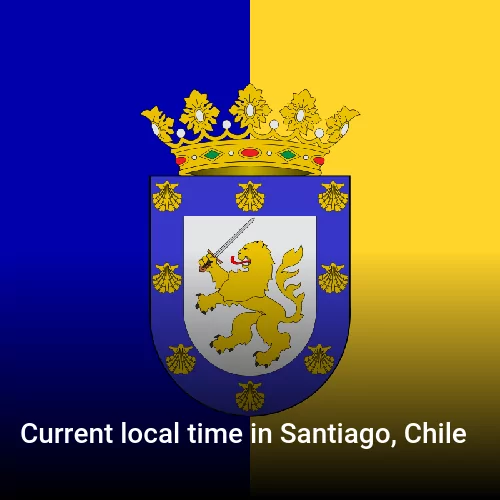In the expansive tapestry of human experience, time functions as both a relentless current and a measured riverbank. Santiago, the vibrant capital of Chile, offers a unique lens through which we can examine the abstract notion of time and its interrelation with culture, geography, and the daily rhythms of life. Understanding the current time in Santiago involves far more than simply glancing at a clock—it invites a contemplation of the multifaceted nature of time as experienced by its inhabitants.
The concept of time in Santiago is intricately woven into the cultural fabric of Chile. Located in the southern hemisphere, Santiago operates under the Chile Standard Time (CLT), which is UTC-3. This time zone offers a stark contrast to the various temporal constructs across the globe. As the sun arcs across the sky from east to west, Santiago embodies both modernity and tradition, echoing the city’s history and its role in the broader narrative of South America.
Weather plays an integral role in shaping the temporal experience in Santiago. The climate, characterized by its Mediterranean-like conditions, varies dramatically throughout the year and contributes to the city’s unique rhythms. Summer, which spans from December to February, basks in long daylight hours, with temperatures often reaching into the high 80s Fahrenheit (mid-30s Celsius). Conversely, winter introduces a stark transformation; June through August casts Santiago into a cooler, more temperate phase, where rainfall can occasionally dampen the vibrant spirit of the city.
The correlation between time and climate is particularly notable during the spring months of September to November when bloom awakens the city, highlighting a palpable resurgence of life. The transitional seasons promote cultural celebrations, from local festivals to gastronomic fairs, creating a synergy between the temporal markers of the calendar and the experiential elements of culture. In this context, the current time serves not merely as a measure but as an invitation to participate in the dynamic flow of Santiago’s seasonal life.
Traveling to Santiago can be an exploration of cultural relativism—a concept positing that one’s beliefs and practices should be understood based on one’s own cultural context rather than being judged against another’s. When visitors consider the current time in this context, they encounter a critical element: the experience of temporal alignment. Time in Santiago does not solely pertain to clocks; it is deeply embedded in local rhythm. The midday break, or “siesta,” underscores a lifestyle distinct from the often relentless pace found in other urban environments. This practice invites visitors to recalibrate their understanding of productivity, leisure, and the passage of time.
Embracing the current time in Santiago, therefore, requires more than mere acknowledgment—it necessitates an immersive approach. One may find that local dining customs reflect a different temporal sensibility. Dinner here typically does not commence until after 8 PM, a testament to the societal inclination towards late-night gatherings that savor both food and community. For a traveler hoping to delve into authentic Chilean cuisine, understanding these societal rhythms allows for a more profound engagement with the culinary landscape.
Moreover, the geographic attributes of Santiago accentuate its relationship with time. Nestled in a valley surrounded by the imposing Andes Mountains, the city’s skyline operates like a natural sundial. The peaks cast shadows that articulate the changing hours throughout the day, prompting inhabitants to orient their schedules within this mountainous embrace. Observing the interplay between the mountains and the sun offers a metaphor for the broader experience of temporality: grounded yet constantly shifting. Travelers intrigued by this natural correlation are encouraged to elevate their horizons—both literally and figuratively—by engaging in hiking expeditions that lead to overlook points where the city unfolds beneath them, momentarily suspending the ordinary measures of time.
Engagement with local customs further illuminates the nature of time in Santiago. A visit to a mercado (market) embodies the vibrant pulse of the city—vendors, shoppers, and the eventual interplay of barter and conversation coalesce in a mosaic of moments. Here, the current time becomes palpable; it transforms as hours dissipate into an intricate tapestry of interactions, crafting a collective narrative that embodies both past and present. Whether browsing for seasonal fruits or local handicrafts, the market offers travelers a tactile experience of the cultural time zone, inviting them to witness how time manifests within the commercial and social lives of residents.
In contemplating the travel experience, it becomes evident that time is not a mere backdrop; it is an active participant in the cultural exchange. Those who navigate the city streets, interact with residents, or simply pause to enjoy Santiago’s public squares become part of an ongoing conversation, where the current time is a shared reference point. Understanding and appreciating this shared temporal experience fosters deeper connections and promotes cultural relativity, as visitors come to perceive time not just as a linear construct but as a violent convergence of individual and communal narratives.
Thus, when assessing the current time in Santiago, one engages with a phenomenon that transcends simple hours and minutes; it is a rich amalgamation of climatic patterns, social norms, and geographical contexts. The interplay between the city and its inhabitants elucidates the profound notion that culture shapes our understanding of time itself. For future travelers, grasping this intricate relationship will yield far richer experiences as they journey through not just Santiago, but the vibrant corridors of human experience that echo from one culture to another.
